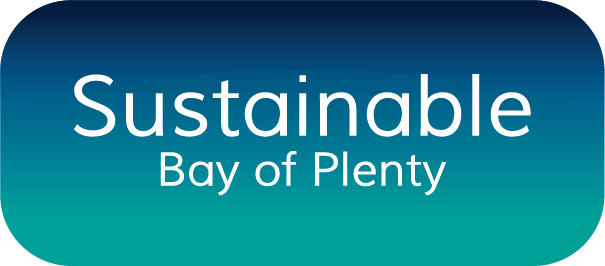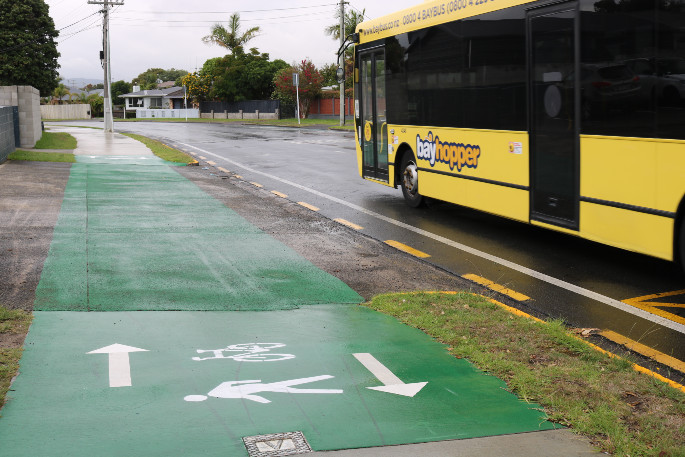In this article, we explain why Sustainable BOP Trust is asking Tauranga City Council and BOP Regional Council to:
- Work with the Mount-Arataki-Papamoa communities to develop sustainable solutions for Links Ave and Farm St.
- Support the community’s ongoing call for bus stops on Maunganui Rd-SH2 by Bayfair, and push to develop bus lanes that connect the B2B and Hewletts Rd.
These are both essential if we are to offer attractive, sustainable and affordable low carbon transport options for our fast-growing city, which are supported by local communities. That means attractive, sustainable and affordable for local residents – as well as for Council and its ratepayers.
The new ‘Tauranga Public Transport Joint Committee’ (Tauranga City Council and BOP Regional Council) held its first meeting on 21 March. This is different to the Regional Council’s ‘Public Transport Committee’, which met a few days earlier and discussed whether to offer completely free fares to Baybus users from April to June this year, rather than just the half price fares the government has funded. (Our view is to tread carefully – no point ending up with unhappy bus users having to pay full fares again on 1st July.)
Strangely, the key decision at the Joint Committee meeting didn’t receive any media coverage. It was to, once again, ignore the wishes of Mount, Arataki and Papamoa residents in regards to Links Ave.
After making it clear TCC had made up its mind to proceed with their latest four+ month trial from 28 March to close off Links Ave, the commissioners are clearly not going to listen to local residents. Commissioner Selwood bluntly stated “the quicker the Papamoa Ratepayers Association realise that the better… their points are noted but we’ve made a decision”.
Which raised a few issues:
1) Tauranga City Council is not just saying no to Papamoa Residents & Ratepayers Association.
- It’s saying no to more than 1500 residents – with 98% explicitly stating they don’t support closing Links Ave.
- It says no to TCC’s own Arataki Community Liaison Group, who they didn’t even engage with about the most contentious issue affecting Arataki.
- It’s also saying no to local community groups (two featured in this recent media story).
- And it says no to several Tauranga-wide community organisations, such as ourselves, who have tried to engage with TCC to support a more sustainable and practical solution.
2) Why did Tauranga City Council ignore the local community and dream up a plan that adversely impacts thousands of local residents? Engaging with an open mind and empowering communities is a far better way to get longer-term buy-in. Ironically, TCC had started to trial that approach with the Arataki Community Liaison Group in 2020, before they changed direction in 2021.
3) At this Joint PT Committee meeting on 21 March, TCC made it sound like a black or white choice between closing Links Ave or leaving it unsafe for children. Yet children only use Links Ave in significant numbers for just over an hour a day, 192 days per year. That’s a very small portion of time, and people have put forward several other options from amongst the very thoughtful feedback from residents.
4) TCC and the community have previously agreed it’s the combination of the cycleway, bus lane and peak time through traffic that made Links Ave unsafe, and it is further exacerbated by the B2B project. Hence many people have asked why TCC doesn’t just change the use of the street for general traffic for a few hours each school day? And whatever the solution, to review it after the B2B finally opens and we see how many vehicles end up using Links Ave.
TCC’s Director of Transport Brendan Bisley recently stated he “is hopeful “common sense will prevail” and suggests the cul-de-sac should only run in business hours, to reduce traffic during school runs, rather than just “blocking access” at Concord Avenue.” We agree. Either way, he acknowledges this is not back and white, so we’d like to see all parties working together on a solution.
5) The response by TCC clearly shows the difference between councillors (who for better or worse, worked with the community) and Commissioners (who seem to be working against this community). That is demonstrated by TCC’s actions and Commissioner Selwood’s statement above. With the Otumoetai Spatial Plan community engagement now open, we hope the Council takes a very different approach with that community.
6) The Councils have decided to remove the bus lane on Links Ave. That seems to make sense in this context, as it is only needed at peak times. So if general traffic is closed off at those times, the bus lane presumably isn’t needed. That also makes the bike lane safer.
Commissioner Tolley stated that Links Ave traffic needs to be reduced to a level appropriate for a residential street, so we hope TCC will monitor this before and after the B2B is completed. And we hope the approach is consistent. For instance, it raised the question for some Arataki locals of whether TCC has the same goal for Farm St?
7) Finally, TCC indicated that it now agrees with BOP Regional Council that the Arataki bus ‘hub’ needs to be smaller than initially imagined, so it most likely won’t be built on the southern side of Girven Rd. The councils have not yet decided where it will go, but the options around Bayfair are limited.
Along with a few others, I was involved for four years in discussions to get the Bayfair underpass added into the B2B project. Part of the rationale was to secure safe and easy access to public transport. We have always said that a full-blown interchange is not needed near Bayfair – instead, we called for two bus stops in each direction (one for local services, one for express), with high-quality shelters and provision for people with limited mobility.
The councils finally seem to agree on the need for bus stops rather than a big interchange, so that’s a big step forward that will save ratepayers millions of dollars. However, some of those bus stops are needed on each side of Maunganui Rd-SH2, as part of the B2B project, to service express buses, intra-regional Baybus services and InterCity buses. Many people want to travel straight from Bayfair to the CBD or vice versa, while others want to go from Bayfair direct to Papamoa or Te Puke. Why should those people miss out on a fast service that is competitive with travel by car? Why should those express buses clog up Farm St?
Our proposal would improve service levels and reduce the number of buses using Farm St and Links Ave, while retaining local bus services to get people to/from the Bayfair hub. Each Maunganui Rd bus stop by Bayfair should have large shelter/s and space for two buses to stop – a Baybus express bus and an InterCity bus stopping to pick up/drop off passengers. Ideally, there would be bus lanes connecting to the Hewletts Rd bus lanes in the near future.
Strangely, at this 21 March meeting, Brendan Bisley dismissed this idea of bus stops and bus lanes on Maunganui Rd-SH2, despite NZTA agreeing to discuss this very topic at an upcoming meeting. He said “an express service doesn’t have bus stops”. Which was news to us, and to some public transport planners I know. More importantly, the council’s own joint transport plan proposed express buses stopping near Bayfair! TCC councillors and staff used to support that goal, so why the sudden change?
Brendan also implied the community is proposing passengers would need to cross SH2, saying “it’s five lanes in places”. He seems to forget there’ll be an underpass at Bayfair, which we requested for precisely that reason. TCC has also previously supported our proposal, as well as another crossing further towards Golf Road, and Bayfair has always been agreed to be the key ‘hub’ in this part of the city.
The community’s proposed solution is an elegant win-win that has been supported by a wide range of individuals, community organisations and businesses for the past four years, and previously by TCC mayor, councillors and staff. We’ve all agreed on the ‘horses for courses’ approach: local buses on local roads, express buses on main roads such as Maunganui Rd, connecting as needed at ‘hubs’.
We’ve been told by TCC that the Cameron Rd project will deliver half the ‘rapid transit’ system needed by our growing city, from the CBD to Tauriko. The other half is from the CBD to Papamoa.
Bus stops on Maunganui Rd-SH2 by Bayfair will allow faster travel in both directions on this key ‘rapid transport’ route that will ultimately link Te Tumu/Rangiuru – Papamoa East – Papamoa – Arataki – CBD – Hospital – Gate Pa – Greerton – Tauriko.
Hence we call on TCC and BOP Regional Council to:
- Work with the Mount-Arataki-Papamoa community to collaboratively develop sustainable solutions for Links Ave and Farm St that are supported by council and community.
- Support the Tauranga community’s ongoing call for bus stops on Maunganui Rd by Bayfair, and urgently work towards developing bus lanes that connect the B2B and Hewletts Rd.
As we head into an important Long Term Plan amendment consultation around some large, expensive projects with equally big implications for the city’s sustainability, we can only hope that TCC will be listening closely to what people want.


In answer to the title question, “Are Councils Listening to Our Communities?’, the answer would seem to be “No” as this substantial analysis describes and then offers – for free – a set of entirely workable solutions. As the years-long efforts by the Arataki and Bayfair residents to persuade Councils to give them solutions that work for them are repeatedly ignored, must we conclude that it is ego, pride, ignorance and mean-spiritedness that drives these council people rather than a spirit of public service? What is the purpose of a council but to serve the expressed needs of its communities?